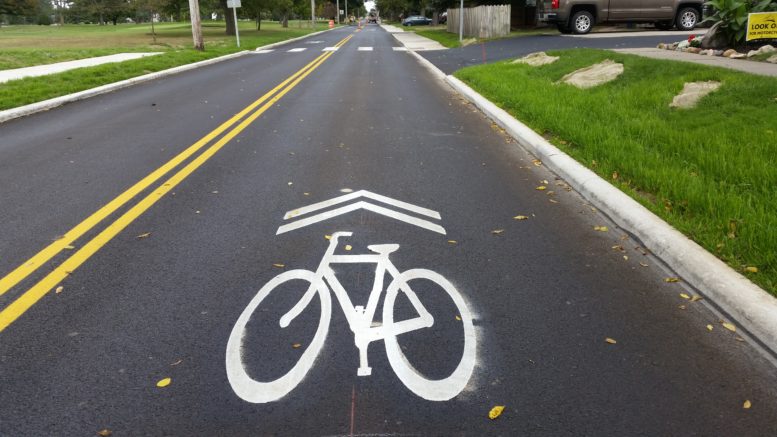By JAN LARSON McLAUGHLIN
BG Independent News
Bowling Green’s Complete Streets program is struggling to fit in accommodations for bicycles.
Bike paths, lanes and sharrows can be expensive – and making space for bikes means taking away space for vehicular travel or parking.
The latest casualty for possible bike accommodations is on East Wooster Street, which will be paved this year from Campbell Hill Road to the CSX railroad tracks, using funds from the Ohio Department of Transportation.
In 2019, the city’s Bicycle Safety Commission suggested that Bowling Green explore bike lanes on seven streets – with East Wooster being one of those.
But Municipal Administrator Lori Tretter explained to City Council on Monday that adding bike lanes on East Wooster Street would create problems for vehicular traffic, and adding a bike path would necessitate costly changes.
The average daily traffic count on East Wooster Street near Interstate 75 is 16,891 vehicles. Closer to downtown, near the CSX tracks, the average daily count is 10,233 vehicles.
Between the tracks and the interstate, East Wooster Street varies from three to four lanes – having at least one east, one west, and one turn lane. The posted speed limits vary from 25 to 40 mph.
To add an on-street bike lane, the city would have to remove the center turn lane, Tretter said.
“We would not recommend that,” she said, noting the large number of rear-end crashes prior to the turn lane being added.
If space were added for a bike lane or separate side bike path, the city would have to move traffic lights, fire hydrants and other infrastructure, Tretter added.
Next year, plans are in place for West Wooster Street to be repaved from Church Street to Haskins Road. That is also on the Bicycle Safety Commission’s wish list for a bike lane.
Kristin Otley, who is a member of the Bicycle Safety Commission, said the group is continuing to update its recommendations for road treatment to accommodate bikes.
“They realize that incorporating on-street bike infrastructure on Wooster has very unique challenges,” Otley said. “They are excited to continue working with all the city departments to facilitate inclusion of bike treatments with other infrastructure projects.”
Tretter also announced at Monday’s City Council meeting that a separate bike lane will be added during the repaving of South Main Street in 2024. That project includes plans for a bike/pedestrian path on the west side of the street from Napoleon Road to Gypsy Lane Road.
The city adopted a long range plan in 2007, identifying several streets to become more bike-friendly. The city later embraced Complete Streets as a concept that calls for roads to be safe and accessible for all modes of travel – including bikes.
The options include bike paths, which are paved areas separate from the roadway; bike lanes, which are lanes specifically for bikes along the edge; sharrows, which use paint on the pavement to remind motorists to share the road with bicyclists; or signs posted alongside the road suggesting drivers to share the pavement.
After the original bike lane map was drawn in 2007, any efforts to modify the roadways appeared to stall out, except for the posting of signs along the roads. For nine years, the map came up occasionally, but the expense or inconveniences seemed to prevent modifications for bicyclists.
Then along came the Complete Streets effort, which seemed to breathe new life into efforts to make Bowling Green streets accommodating to more than just motor vehicles.
Grandiose plans were envisioned, with many streets identified as possible “bike routes” around the city.
In 2016, it was decided that efforts to add accommodations for bicycles must come earlier in the planning process. The timing problems came to light when decisions about Conneaut and Fairview avenues had to be rushed due to bidding requirements.
The city considered widening Conneaut and making lanes for bicyclists the entire length of the street. The option of creating a bike lane on Fairview fell out of favor early on because of logistical problems with neighbors and the golf course.
Ultimately, the decision was made to forgo the street widenings and add sharrows instead.
Then last year, sharrows were added to Thurstin Street and Manville Avenue. Two other streets – Clay and South Maple – were in line for paving and were recommended to get sharrows by the city’s Bicycle Safety Commission.
While Clay Street was a low priority for the bike commission, Maple Street ranked high for bike accommodations since the street links Bowling Green City Park with the Slippery Elm Trail.
But later in 2020, Bowling Green City Council’s Transportation and Safety Committee put those bike sharrows on hold in order to save parking on Clay and Maple streets.

